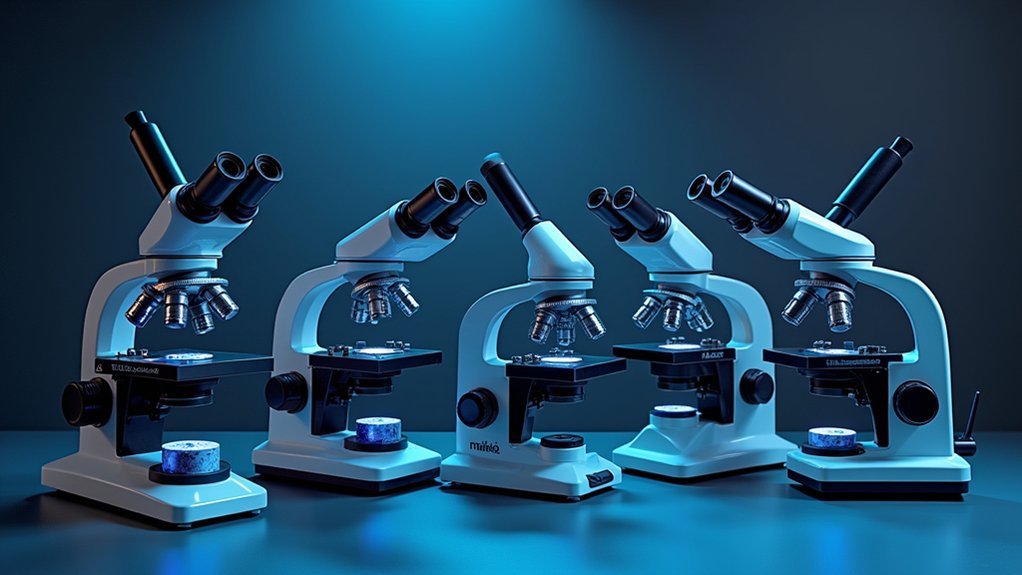Phase contrast microscopes range from $8,000-$15,000 for entry-level models suitable for teaching to $50,000+ for premium systems with advanced automation. Budget options provide basic functionality while mid-range systems offer modular designs that balance performance and affordability. High-end models justify their cost through superior optics, automated features, and reduced maintenance needs. Your ideal choice depends on application requirements, long-term ROI considerations, and specific imaging needs. The full comparison reveals which features truly matter for your lab.
Understanding Phase Contrast Technology: From Basic to Advanced Systems

While invisible to the naked eye, phase shifts in light waves become powerful visualization tools through phase contrast microscopy. This technology transforms transparent specimens into clearly visible images without stains, making it invaluable for observing live cells in their natural state.
Basic phase contrast microscope systems ($8,000-$15,000) deliver essential functionality for undergraduate labs and routine research applications. For more demanding life science research, advanced phase contrast systems from manufacturers like Olympus and Zeiss integrate proprietary technologies that enhance image clarity and enable seamless changes between microscopy modes.
The innovation landscape continues to evolve with Olympus’s IX3 series featuring specialized optical coatings and Nikon’s Eclipse Ti2 that minimizes focus drift—critical advancements for extended live-cell imaging sessions where precision and stability are paramount.
Entry-Level Phase Contrast Microscopes: Features and Price Points
Despite their classification as “entry-level,” today’s affordable phase contrast microscopes deliver impressive capabilities for educational and basic research settings. Priced between $8,000 and $15,000, these systems provide excellent value for undergraduate labs and smaller research facilities.
You’ll find these microscopes equipped with modular designs allowing customization with various objectives and condensers to enhance contrast when viewing biological samples. Most models offer magnification of 10x and higher, perfect for observing living cells in real-time.
Manufacturers like Olympus and Leica have created user-friendly designs with adjustable condensers and simplified phase contrast units. These thoughtful features make it easier for students and researchers to achieve clear visualization of transparent specimens without complex setup procedures.
Mid-Range Systems: Balancing Performance and Affordability

Moving beyond entry-level options, mid-range phase contrast microscopy systems offer a sweet spot for laboratories needing advanced capabilities without breaking the bank. Priced between $8,000 and $15,000, these systems deliver reliable performance with modular designs that accommodate various contrast methods alongside traditional phase contrast.
You’ll find popular options like the Olympus IX3 with its specialized optical coatings and the Nikon Eclipse Ti2, which minimizes focus drift during high magnification work. These features make mid-range systems particularly valuable for biomedical research and clinical diagnostics where cellular imaging quality is paramount.
Statistics show that 78% of academic labs with modest budgets prefer manufacturers like Leica and Thorlabs, confirming that these systems successfully balance affordability with the advanced functionality needed for professional research applications.
Premium Phase Contrast Microscopes: What Justifies the Higher Cost?
When laboratories invest in premium phase contrast microscopes like the high-end Olympus and Zeiss models, they’re paying for more than just brand names.
You’re acquiring cutting-edge optical technologies that deliver exceptional clarity for live-cell imaging. These $50,000+ systems feature proprietary innovations—Olympus’s specialized coatings and Zeiss’s Apotome technology—that enhance performance across multiple microscopy modes.
Premium phase contrast microscopes offer significant workflow improvements through automated focus systems and machine learning algorithms for cell counting.
Their modular design allows customization for specific research applications, making them versatile investments across disciplines. The higher price also reflects durability, reliability, and thorough support services that guarantee your equipment maintains peak performance throughout its extended lifespan.
These advantages collectively justify the investment for labs requiring superior imaging capabilities.
Key Specifications to Consider When Comparing Phase Contrast Systems

When you’re comparing phase contrast systems, you’ll need to prioritize the magnification range (typically 10x to 1,600x) to guarantee you can properly visualize your specific specimens at appropriate resolutions.
Your results will depend heavily on the quality of the condenser system, so look for adjustable condensers with built-in light sources that enhance visibility and contrast in live cell imaging.
The right combination of magnification capabilities and superior condenser quality will dramatically improve your ability to observe unstained specimens with clear definition of cellular structures.
Magnification Range Matters
The microscope’s magnification range serves as a critical factor when comparing phase contrast systems for your research or educational needs. Most systems offer between 4x to 100x magnification, but specialized models can reach up to 1,500x for detailed cellular observation.
Consider your application requirements when selecting an appropriate phase contrast system. Advanced models like the BMC5 Series provide exceptional range for professional research, while educational models offer standard configurations.
| System Type | Magnification Range | Best Application |
|---|---|---|
| Standard | 4x-100x | General observation |
| Advanced | 40x-1,600x | Research facilities |
| Specialized | Up to 1,500x | Detailed cellular studies |
| Educational | 4x, 10x, 40x, 100x | Teaching labs |
If you’re using an inverted microscope like the Eclipse Ts2R, you’ll benefit from its versatile magnification capabilities while maintaining a compact footprint.
Condenser Quality Determines Results
Since image clarity relies heavily on light manipulation, condenser quality serves as the cornerstone of effective phase contrast microscopy.
You’ll notice striking differences in image resolution when using a high-quality condenser with properly matched phase annuli for your objectives.
When comparing systems, focus on condensers with adjustable apertures that let you fine-tune light entry for ideal high contrast in various samples.
The working distance matters considerably—longer distances accommodate larger specimens while maintaining focus, an essential feature for extensive biological studies.
Don’t overlook condensers with advanced optical coatings, as these enhance light transmission while reducing aberrations.
Your phase contrast system’s overall performance largely depends on these seemingly small details, ultimately determining whether you’ll capture subtle cellular structures or miss vital details in your specimens.
Specialized Applications and Their Optimal Phase Contrast Solutions
Matching the right phase contrast system to your specific research needs can dramatically improve results across diverse scientific applications.
The strategic selection of phase contrast technology tailored to research specifics elevates scientific outcomes across disciplines.
For life sciences involving living cell observation, Olympus’s IX3 series with patented optical coatings delivers exceptional clarity.
Zeiss’s Axio Observer platform serves academic environments where versatility across microscope uses is essential, allowing seamless shifts between imaging modes.
For advanced biomedical applications, consider Nikon’s Eclipse Ti2 with its Perfect Focus System and wide field of view—ideal for high-throughput screening.
Histological studies benefit from Leica’s Thunder Imaging systems, which computationally enhance thick tissue sample visualization.
If you’re equipping an undergraduate teaching lab, entry-level Thorlabs models ($8,000-$15,000) offer quality phase contrast capabilities without breaking departmental budgets while maintaining essential imaging standards.
Return on Investment: Evaluating Long-Term Value of Various Price Tiers

When evaluating phase contrast microscopes across different price points, you’ll find that entry-level systems ($8,000-$15,000) offer excellent educational value while premium models from Zeiss and Olympus provide superior long-term returns for research institutions.
Your maintenance costs will typically remain lower with established brands, as evidenced by the 62% of pharmaceutical companies standardizing on these manufacturers for their reliability.
Government funding trends further validate investing in higher-tier systems, where the initial price premium often translates to extended equipment lifespan and enhanced research capabilities that justify the expenditure over time.
Price-to-Performance Ratio
Although initial costs may seem intimidating, evaluating the price-to-performance ratio of phase contrast systems reveals distinct value propositions across different market segments.
When analyzing these sophisticated microscopy solutions, you’ll find that modular systems often deliver superior long-term value by allowing strategic upgrades as your needs evolve.
Consider these critical factors when evaluating price-to-performance ratio:
- Entry-level systems ($8,000-$15,000) provide excellent value for teaching environments, balancing affordability with core functionality.
- Premium research models ($50,000+) justify their cost through superior image quality and specialized capabilities that directly impact research outcomes.
- Subscription-based feature pricing ($2,000-$5,000 annually) enables access to cutting-edge capabilities without large capital expenditures.
The 62% of pharmaceutical companies standardizing on premium brands demonstrates how high-performance phase contrast systems often justify their higher investment through improved research output.
Maintenance Cost Analysis
A thorough maintenance cost analysis reveals that the true value of phase contrast systems extends far beyond their initial purchase price. When you’re investing $8,000-$50,000+ in microscopy equipment, understanding long-term maintenance costs becomes essential for accurate ROI calculation.
| Cost Factor | Budget Systems | Mid-Range | Premium Phase Contrast |
|---|---|---|---|
| Parts Replacement | Low cost, frequent | Moderate | Higher cost, infrequent |
| Service Contracts | Limited coverage | Extensive | Full coverage with priority |
| Downtime Impact | Significant | Moderate | Minimal |
| Calibration Needs | Manual, frequent | Semi-automated | Automated, less frequent |
Regular maintenance is essential regardless of your price tier, but premium systems typically offer better durability and fewer service interruptions. While their parts may cost more, you’ll need them less frequently. Consider how equipment downtime affects your research productivity when calculating the true cost of ownership.
Frequently Asked Questions
Is Phase Contrast Worth It?
Yes, phase contrast is worth it. You’ll observe living cells without staining, giving you authentic cellular behaviors. It’s particularly valuable if you’re doing biomedical research where detailed, unaltered cell analysis is essential.
What Type of Microscope Is More Expensive?
Phase contrast microscopes are more expensive than standard optical microscopes. You’ll pay $8,000-$15,000 for entry-level models, while premium systems from brands like Olympus and Zeiss can exceed $50,000 for advanced research applications.
What Are the Disadvantages of Phase Contrast Microscope?
You’ll face several disadvantages with phase contrast microscopes: they’re expensive ($8,000-$15,000), require precise alignment, produce image-distorting halos, struggle with highly transparent specimens, and face regulatory hurdles in clinical settings.
How Much Should I Pay for a Microscope?
You should pay $8,000-$15,000 for a standard phase contrast microscope, though your needs may dictate spending anywhere from $40 for basic models to $50,000+ for premium research systems with advanced features.
In Summary
When choosing a phase contrast system, you’ll want to balance your budget against your specific research needs. Don’t be swayed by premium features you won’t use. Entry-level models serve basic applications well, while mid-range options offer the best value for most labs. Premium systems are worth the investment only when your work demands their advanced capabilities and precision.





Leave a Reply